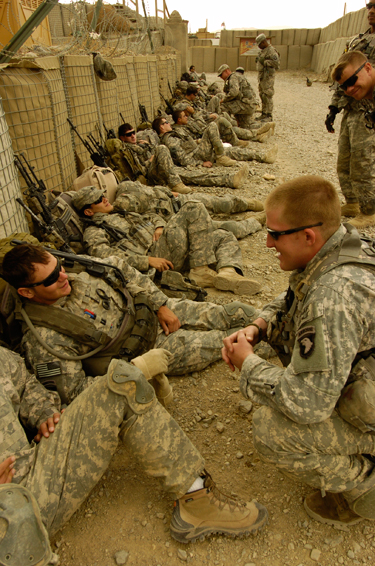Luck on the battlefield is a good thing. Had Griechen and the two others not moved when they did, they likely would have been killed. The enemy mortar team had indeed adjusted their fire to target the medic’s original position. Less than a minute after the three ran for the command post, their position took a direct hit from a mortar.
The command post, shielded from direct fire by a boulder, was a hive of activity. Every rifle and machine gun in the platoon was firing. The mortar carrier had fired all 13 of his 60mm rounds in about two minutes and had switched to his rifle. As soon as Griechen had bandaged Sommers’ head, the decision was made to move 60 yards up the hill to where the Air Force controllers and intelligence crew were posted.
Griechen and three others put Sommers on a litter and set off up the hill, under fire. When they reached the new position, Roberson started an IV, but the incoherent soldier, flailing about, dislodged it, and it had to be done again.
 Suddenly a gigantic explosion sent a couple of soldiers flying through the air — unharmed, as it turned out. Peacock’s crews back in Boris had gotten the OK to fire, but their first round, though accurate, had hit too close for comfort. Butler called in a correction, and the long guns shifted their pounding fire to the opposite slope, closer to the insurgents.
Suddenly a gigantic explosion sent a couple of soldiers flying through the air — unharmed, as it turned out. Peacock’s crews back in Boris had gotten the OK to fire, but their first round, though accurate, had hit too close for comfort. Butler called in a correction, and the long guns shifted their pounding fire to the opposite slope, closer to the insurgents.
Back at Boris, Peacock worked feverishly to keep the wall of steel between the Americans and the enemy. His crew’s guns have fired more counter-fire missions than any other guns in eastern Afghanistan. With the size of the American patrols being so small, artillery and air power often make the difference between life and death. Peacock’s job was twice as difficult as it should have been that night: An accident had put one of his two guns, along with its crew, out of action. A bad fuse apparently had allowed a round to explode as it left the barrel of the gun, and six crewmembers were wounded. Had the explosive gone another 30 feet, it would have killed everyone in the other gun crew.
On the mountain Jarmuz was calling for a medevac and air strikes. The medevac would take at least another 20 minutes to arrive. The air strike would get there first. A French Mirage jet made contact with the air controllers, and Butler directed the pilot where to drop the 500-lb laser-guided bomb.
Unfortunately, the pilot pulled up on his first approach and went around, giving the insurgents time to take cover. On his second run, he released, and the bomb hit close to the target Butler had aimed him at. Only about seven minutes had passed since the fight started, but it seemed like a lifetime to those men on the mountain.
In the ensuing lull, it was the insurgents’ turn to regroup. They knew that they were in danger: Peacock’s guns were already finding their mark, and aircraft were on station, making escape much more difficult. They knew that if they were caught on the mountain after dark, they would almost certainly be killed by the Apaches that stalk them in the night.
By this time, Roberson had laid down the smoke canister to mark the landing zone for the Blackhawk, and the Apache pilots gave the go-ahead. Less than a minute later, Sommers was on his way to OE.
Griechen had won the battle on the mountain to keep Sommers alive, and Peacock had kept the enemy at bay with withering fire. The exclamation point came when an American F-15 delivered its 2,000-pound bomb on the enemy fighting positions. Later assessments would show that Butler’s targeting for the bombs and artillery had killed almost 40 fighters.
Still to come was the terrifying 10-hour march off the mountain for 2nd Platoon. Jarmuz figured that getting his men off the mountain was the better part of valor: Even though they had not been able to set up their ambush on the insurgents who’d been shelling Margah, they had engaged a large enemy force and inflicted significant casualties.
As they neared the base of the mountain, Jarmuz judged that it was safe for his troops to put aside their night-vision goggles, as their poor depth-perception qualities had contributed to many falls during the trek, and to turn on lights to help them find their way down.
Thirty minutes later, when they hit the road, two trucks, commandeered by their compadres back at Margah arrived to pick them up and drive them back. As bad as Margah was, there’s no place like home.
The battle by Jarmuz’ platoon on the mountain did nothing to change the overall strategic picture in Afghanistan. But those kinds of actions continue to take their toll on the enemy. It is obvious that more and more “green” insurgents are in the battle. The veterans are taking more of a leadership and training role and putting the “new guys” out to do battle with the Americans. Combine that with a dramatic increase in missile strikes in the tribal region just east of Margah and Boris, and the generals in Kabul will tell you that we’re making “significant progress” but that it will be a long, slow fight.
When the platoon flew back to Boris, they were haggard, exhausted, and emotionally drained. What was to be a routine mission had turned into a life-and- death struggle, with one of their friends gravely wounded. For days no one in the platoon wanted to talk about it. They just wanted to get clean and eat and sleep. And Jarmuz and Watson let them do just that.
Seven months later, Abu Company is leaving Afghanistan in bits and pieces. Most of the unit will be home by the end of January. These last few weeks can’t go by fast enough.
Since I left Afghanistan in August, several significant things have happened. First and foremost was the death of Specialist Jimmy “Big Rob” Robinson — a machine gun team leader; graduate of Monroe, Ohio’s Lemon-Monroe High School; husband to Kate; and loving father of two — during a mortar attack on FOB Boris. I still have gear that Jimmy hooked me up with at Margah.
Sommers is in Florida. His prognosis is good, but his head injury was so severe that his doctors’ predictions for his long- term recovery change from day to day.
After Abu Company left Margah for FOB Salerno and points north, a force of 120 insurgents foolishly decided to try and overrun the 20-plus Americans at Margah on Halloween. At the end of the fight, 92 insurgents had been killed and two captured. Five Americans were lightly wounded.
Lastly, Nasiruddin Haqqani, son of the infamous insurgent leader Jalaluddin Haqqani, has reportedly been arrested by Pakistani authorities. Following his arrest, there were an unprecedented four drone strikes on one village in 24 hours, a clear indication that Americans know where the Haqqani leadership is and that they’re going after them.
I’d like to thank the men and leadership of Abu for their trust, hospitality, cooperation, and friendship. Without it, photographer/videographer Bill Putnam and I could not have produced this story.
Don Jones can be reached at lopull@gmail.com.
Bill Putnam can be reached at Bill.putnam1@gmail.com. More of his work can be seen at www.billputnam.net.
{gallery}01122011{/gallery}











